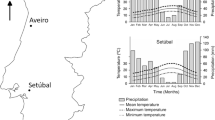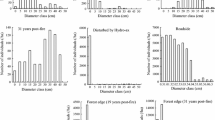Abstract
Pine forests are declining because of pine wilt disease and Robinia pseudoacacia, a nitrogen-fixing species, is dominating coastal forests along the Sea of Japan. We examined the effects of R. pseudoacacia on the regeneration of a native pine species, Pinus thunbergii. Two 200 m2 plots were set up at the border of a P. thunbergii and R. pseudoacacia-dominated area in a coastal forest. We conducted monthly censuses of emergence, distribution and survival of pine seedlings in the plots from May 2003 to December 2004. Light intensity and soil properties were also measured to analyze the relationships between the survival of pine seedlings and environmental conditions using the Mantel test and the structural equation model. Pinus thunbergii seedlings emerged in spring–early summer and in late autumn. Survival of pine seedlings in the R. pseudoacacia-dominated subplots was less than half that in the pine-dominated subplots. Survival of pine seedlings emerging in May 2003 was significantly reduced by the lower light intensity and higher soil nitrogen in R. pseudoacacia-dominated subplots. The tendency was the same for seedlings emerging from April to May 2004. We concluded that R. pseudoacacia reduced the intensity of light during the growing season and increased the nitrogen content of soil, which resulted in inhibition of the natural regeneration of P. thunbergii.





Similar content being viewed by others
References
Boring LR, Swank WT (1984) The role of black locust (Robinia pseudoacacia) in forest succession. J Ecol 72:749–766
Catovsky S, Bazzaz FA (2002) Nitrogen availability influences regeneration of temperate tree species in the understory seedling bank. Ecol Appl 12:1056–1070
Chun YM, Lee HJ, Lee CS (2006) Vegetation trajectories of Korean red pine (Pinus densiflora Sieb et Zucc) forests at Mt. Seorak, Korea. J Plant Biol 49:141–152
Duchesne LC, Paterson RL, Ellis BE (1987) Interaction between the ectomycorrhizal fungus Paxillus involutus and Pinus resinosa induces resistance to Fusarium oxysporum. Can J Bot 66:558–562
Duchesne LC, Paterson RL, Ellis BE (1989a) The time-course of disease suppression and antibiosis by the ectomycorrhizal fungus Paxillus involutus. New Phytol 111:693–698
Duchesne LC, Ellis BE, Paterson RL (1989b) Disease suppression by the ectomycorrhizal fungus Paxillus involutus: contribution of oxalic acid. Can J Bot 67:2726–2730
Futai K, Tamai S, Yamanaka N, Yamamoto F (2002) Ecophysiological studies on pine wilt disease occurring in coastal dunes. Nematol 4:251–252
Hausdorf B, Hennig C (2005) The influence of recent geography, palaeogeography and climate on the composition of the fauna of the central Aegean Islands. Biol J Linn Soc 84:785–795
Huber DM, Watson RD (1974) Nitrogen form and plant disease. Annu Rev Phytopathol 12:139–165
Ishikawa M (1992) The functions and estimations of environment conservation in coastal forests. In: Murai H, Ishikawa M, Endo J, Tadaki Y (eds) Japanese coastal forests: the many sided environmental functions and the applications (in Japanese). Soft Science, Tokyo
Kawata H (1987) Difference of nutrient amounts returned to soil by litter falls and their effects on soil properties between Pinus thunbergii and Robinia pseudo-acacia forests in coastal sand dune (in Japanese with English abstract). Bull Niigata Univ For 20:51–66
Kojima T (2003) Structural equation modeling and graphical modeling learned with Excel (in Japanese). Ohmsha, Tokyo
Kurauchi I (1956) Salt spray damage to the coastal forest (in Japanese with English abstract). Jpn J Ecol 5:123–127
Landgraf D, Wedig S, Klose S (2005) Medium and short-term available organic matter, microbial biomass, and enzyme activities in soils under Pinus sylvestris L. and Robinia pseudoacacia L. in a sandy soil in NE Saxony, Germany. J Plant Nutr Soil Sci 168:193–201
Maekawa M, Nakagoshi N (1997) Impact of biological invasion of Robinia pseudoacacia on zonation and species diversity of dune vegetation in Central Japan. Jpn J Ecol 47:131–143
Mori A, Takeda H (2003) Light-related competitive effects of overstory trees on the understory conifer sapling in a subalpine forest. J For Res 8:163–168
Nasir H, Iqbal Z, Hiradate S, Fujii Y (2005) Allelopathic potential of Robinia pseudoacacia L. J Chem Ecol 31:2179–2192
Oda T (1989) On the regeneration method of coastal Japanese black pine (Pinus thunbergii) forest (I) Population dynamics of pine seedlings (in Japanese). The 100th annual meeting, The Japanese Forestry Society, Academic Conference Papers, pp 681–682
Ogasawara R, Ishibashi S (1986) The natural regeneration in the pine forests (Pinus densiflora, P. thunbergii) in the West-Daisen state forest research (in Japanese). Bull Tottori Univ For 16:215–226
Papavizas GC, Lewis JA, Adams PB (1967) Survival of root-infecting fungi in soil. Influence of amendment and soil carbon-nitrogen balance on Fusarium root rot of beans. Phytopathology 58:365–372
Peloquin RL, Hiebert RD (1999) The effects of black locust (Robinia pseudoacacia L.) on species diversity and composition of black oak savanna/woodland communities. Nat Area J 19:121–131
Rice SK, Westerman B, Federici R (2004) Impacts of the exotic, nitrogen-fixing black locust (Robinia pseudoacacia) on nitrogen-cycling in a pine-oak ecosystem. Plant Ecol 174:97–107
Scheidemann P, Wetzel A (1997) Identification and characterization of flavonoids in the root exudates of Robinia pseudoacacia. Trees 11:316–321
Smith SE, Read DJ (1997) Mycorrhizal symbiosis. 2nd edn. Academic, New York
Smouse PE, Long JC, Sokal RR (1986) Multiple regression and correlation extensions of Mantel test of matrix correspondence. Syst Zool 35:627–632
Tadaki Y (1992) The ecological succession in coasts and coastal forests. In: Murai H, Ishikawa M, Endo J, Tadaki Y (eds) Japanese coastal forests: the many sided environmental functions and the applications (in Japanese). Soft Science, Tokyo, pp 52–57
Tamai S, Yamanaka K (1997) The effect of removal of A0 layer from the floor of a sand dune forest for Japanese black pine (Pinus thunbergii) of seedling dynamics of P. thunbergii (in Japanese with English abstract). Sand Dune Res 44:6–14
Tanaka K (1992) Revegetation and management of coastal forests after Meiji Period. In: Murai H, Ishikawa M, Endo J, Tadaki Y (eds) Japanese coastal forests: the many sided environmental functions and the applications (in Japanese). Soft Science, Tokyo, pp 7–16
Taniguchi T, Kanzaki N, Tamai S, Yamanaka N, Futai K (2007) Does Ectomycorrhizal fungal community structure vary along a Japanese black pine (Pinus thunbergii) to black locust (Robinia pseudoacacia) gradient? New Phytol 173:322–334
Toussoun TA, Nash SM, Snyder WC (1960) The effect of nitrogen sources and glucose on the pathogenesis of Fusarium solani F. phaseoli. Phytopathology 50:137–140
Washitani I, Tang Y (1991) Microsite variation in light availability and seedling growth of Quercus serrata in a temperate pine forest. Ecol Res 6:305–316
Weinke KE (1962) The influence of nitrogen on the root disease of bean caused by Fusarium solani F. phaseoli. Ph.D. thesis, University of California, Berkeley, CA
Yamamoto K (2003) LIA32. http://www.agr.nagoya-u.ac.jp/~shinkan/LIA32/index-e.html
Zhu J, Matsuzaki T, Lee F, Gonda Y (2003) Effect of gap size created by thinning on seedling emergency, survival and establishment in a coastal pine forest. For Ecol Manage 182:339–354
Acknowledgments
This study was joint research by the Graduate School of Agriculture, Kyoto University and the Arid Land Research Center, Tottori University. We thank Junichi Kikuchi, Faculty of Education, Nara University, Yuko Takeuchi, Laboratory of Environmental Mycoscience, Kyoto University, and Dr Sumiko Kaihara for their valuable suggestions. We are also grateful to Dr Takashi Osono, Graduate School of Agriculture, Kyoto University, for measurement of soil conditions.
Author information
Authors and Affiliations
Corresponding author
About this article
Cite this article
Taniguchi, T., Tamai, S., Yamanaka, N. et al. Inhibition of the regeneration of Japanese black pine (Pinus thunbergii) by black locust (Robinia pseudoacacia) in coastal sand dunes. J For Res 12, 350–357 (2007). https://doi.org/10.1007/s10310-007-0023-y
Received:
Accepted:
Published:
Issue Date:
DOI: https://doi.org/10.1007/s10310-007-0023-y




